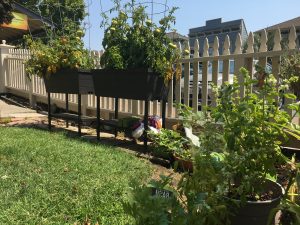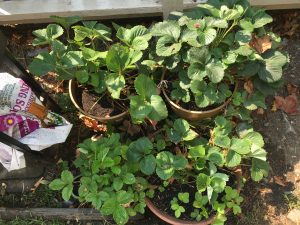Management skills via container gardens
I really want a yard but we live in the Bay Area, which makes space really expensive. For now my family shares a tiny yard with our downstairs neighbors and, because I was too shy to ask, I spent our first 4 summers here without any sort of garden.
This spring I asked the ladies downstairs if we could put a few potted plants out, to which they said “duh, totally, we don’t care at all.”
Takeaway #1 from this post: ASK. Most of the time, the thing you’ve been dreaming about will not bother anyone else in the least.
So this is how I ended up with a sweet little container garden. We only planted the things I knew we would eat: tomatoes, cucumbers, strawberries, basil and a few other herbs. Between calls I would go check on things… and maybe it’s because I coach growing adults all day, but our garden became an ongoing visual metaphor for everything happening on my clients’ teams.
Here’s what I learned about humans, growth and groups from our container garden this year:
Plants need different degrees of sunlight for varying hours of the day.
Off the bat, I did not choose vegetables that required a different type of yard. We have full sun for a good stretch of the day and shade after that. I checked with the gardeners at the local nursery to make sure I wasn’t trying to grow things unsuccessfully from the start.
Are you hiring junior resources and expecting them to do senior-level work? Are you promoting folks into leadership roles and then giving them so much work in the weeds that they have no time to manage? Know what kind of environment you’re offering… and then hire accordingly.
Half our plants needed water daily; half our plants were drowned by daily watering.
How annoying, right? It would have been so much easier if we could have an all-or-nothing approach but the more I got to know the plants, the more nuance I noticed.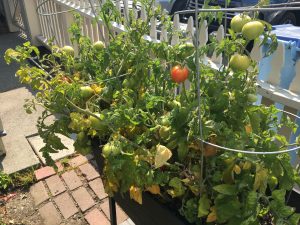
As leaders, we want a one-stop solution to managing people. But people, like plants, thrive under different conditions. The cadence of 1:1 meetings with your reports does not have to be the same for each person. Have someone who prefers monthly conversations? Book it. Have another person who shines with more regular check-ins, perhaps weekly? Book them. There is no law that says your rhythms have to be the same across the board.
(*Note: For 1:1s, I wouldn’t go less frequent than monthly. Too much changes in a month.)
Cucumbers need stability.
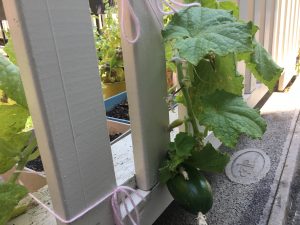 The cucumbers were moody as hell. First, they were growing left. Then they swerved right. On the DAILY, they were changing which direction they were headed… and finally, I realized they were looking for a path. I tied the vines to the fence and let them spread out, relieved to have found backbone for their direction.
The cucumbers were moody as hell. First, they were growing left. Then they swerved right. On the DAILY, they were changing which direction they were headed… and finally, I realized they were looking for a path. I tied the vines to the fence and let them spread out, relieved to have found backbone for their direction.
You will have some very self-motivated folks on your team. But you will also have people who are looking for direction. When that’s the case, connect them to a path. Secure them for a period of time to a mission, a project, a goal. Even the most motivated of people are lost sometimes.
Tomatoes shape each other.
Sometimes a few tomatoes start growing in a little pocket. Their little flowers are close together and it’s so charming… but as they get larger and take up more space, their
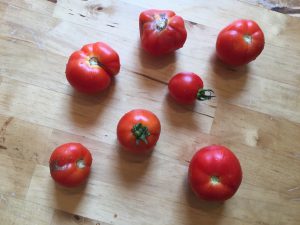
growth paths run them into each other. Tomatoes don’t care and I don’t either… they taste the same, but it affects their shape. When they grow too close to another, they end up with flattened sides, squashed tops or funky bodies.
Team dynamics work this way, too. When we have folks who are growing too closely, they will push each other to make room for their own growth. Sometimes this is fine and you end up with uniquely-shaped team members who are healthy and thriving! But sometimes the squashing results in rot… and in these cases, it is best to prune one or two off the vine for the greater good.
Strawberries are overachievers.
I read that you should only let a strawberry plant have 3 daughter plants. (Strawberries are these crazy little plants that send shoots out to start new ones All. The. Time.) It hurt to imagine cutting the shoots they were churning out! But then I realized they were not producing any fruit because they were spending all their energy on new plants.
BEWARE! If one of your employees loves starting projects, they might be a total strawberry. Make sure they’re focusing their energies to go deep on a few efforts rather than making shallow work happen everywhere.
Basil has a lifespan.
Basil is such a no-brainer because it’s easy to grow and you don’t have to pay $2 for a couple leaves at the grocery store. But at a certain point basil starts going to flower (which means that it’s not as good and it’s kind
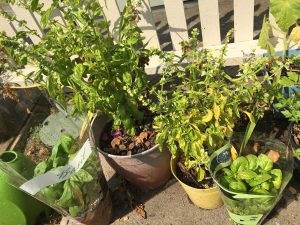
of yellow). You can starve off the flowers by pruning them and removing them from the tops for a while… but at a certain point, you gotta call it quits. Dump the old plant and buy a new one at Trader Joe’s.
Some people have fully lived their lifecycle in their current environment. Things have run their course and you have pruned, supported and done enough. When your employee has gone to flower and they’re ready to move on, departures are welcome on all ends. It’s time for a new adventure for your employee… and a time to welcome a new member to the team.
***
The metaphors are endless and I could write a hundred posts about it all but I leave you today with this thought:
Growth, via plant OR animal, is the same. You have a limited amount of time and energy. Make sure you are growing what you want to be growing. Take care of different species differently. It’s ongoing, hard work to grow a team, as it is with a garden… but the fruits of your labor are so worth it.
Spending time with a team that you’ve curated and watched evolve? This is good, fulfilling work, managers. Keep it up.
Are you a manager? Do you love gardening in tiny spaces? We’ll talk about the nuts & bolts of managing, build community and have bigger conversations about empowering humans at Plucky’s next manager workshop! Find out more details here.
